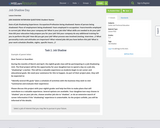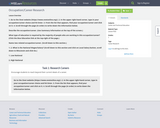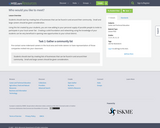
Career database provides tools and resources for career exploration
- Subject:
- Career and Technical Education
- Material Type:
- Interactive
- Reference Material
- Author:
- MyPlan.com
- Date Added:
- 05/23/2018

Career database provides tools and resources for career exploration

This lesson is designed to help students move from their Foundational SAE to an Immersion SAE. The students will continue to work on their Foundational SAE project based on their career interest, but they will also be introduced to Immersion SAEs. The teacher may choose to only use the Foundational SAE project to get started, but they should work toward helping their students move their SAE project to include one or more Immersion SAE projects. The students will participate in weekly Immersion SAE record keeping. Starting SAE projects in the classroom should be simple for the teacher and students. Minimum expectations that can still produce success for all students would be tracking 1-hour of SAE time per week, exploring one career topic per week, and recording one financial entry per month. A final report or project at the end of the class would also be a minimum expectation for all students. Over time the students expectations for their Immersion SAE projects can be expanded to include more record keeping and financial entries.

JOB SHADOW INTERVIEW QUESTIONS Student Name: Date of Job Shadowing Experience: Occupation/Profession being shadowed: Name of person being shadowed: Place of employment being shadowed: Years employed in occupation: Years/months employed in current job: What does your company do? What is your job title? What skills are needed to do your job? How did your education help prepare you for your job? Did your company do any additional training for you to perform this job? How did you get your job? What process was involved (testing, interview...)? What personality traits and attitudes are important? What related jobs did you have before this job? What is your work schedule (flexible, nights, specific hours...)?

1. Go to the Onet website (https://www.onetonline.org/). 2. In the upper right-hand corner, type in your occupation/career choice and hit Enter. 3. From the list that appears, find your occupation/career and click on it. 4. Scroll through the page (in order) to write down the information below. Describe the occupation/career. (Use Summary information at the top of the screen.) What type of education is required by the majority of people who are working in this occupation/career? (Click the blue Education link at the top-right of the page.) Name two related occupation/career. (Scroll down to this section.) 1. 2. What is the National Wages/Salary? (Scroll down to this section and click on Local Salary button, scroll down to Wisconsin and click Go.) 1. Low National 2. High National

Students should start by creating lists of businesses that can be found in and around their community. Small and large careers should be given consideration. Using this list created by your students, you are now adding to your personal supply of possible people to invite to participate in your local career fair. Creating a solid foundation and networking using the knowledge of your students can be very beneficial in opening new opportunities to your school district.